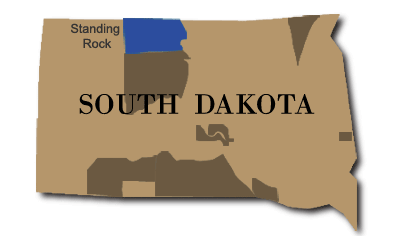|
|
 |

About the Yanktonai, Hunkpapa, and Blackfoot Sioux: The Siouan language family, including Lakota-Dakota-Nakota speakers, inhabited over 100 million acres in the upper Mississippi Region in the 16th and early 17th centuries. Conflicts with the Cree and Anishabe Indians, as well as the lure of the Great Plains’ buffalo herds, incited the Sioux to move further west in the mid-17th century. The Lakota acquired horses around 1740. Shortly thereafter, the Tribe crossed the Missouri River, arriving in the Black Hills in 1775. About this time, the Lakota divided into seven tribes, the Oglala, Brule, Minnecoujou, Hunkpapa, Blackfeet, Without Bows, and Two Kettle. The Lakota, as is typical of Plains Indian tribes, lived in organized bands, and relied on buffalo for food and clothing.
History of the Reservation: The terms of the Fort Laramie Treaty of 1868 placed the Lakota on one large reservation that encompassed parts of North Dakota, South Dakota, and four other states. After the United States defeated the Indian tribes in the Indian Wars of the 1870s, the US Government broke the Lakota’s original reservation into several smaller ones. Not only did the U.S. government reduce the Indians’ acreage, it also splintered the Tribe. In 1889 the United States reclaimed 7.7 million acres of the Sioux’s sacred Black Hills and moved the Teton Sioux to the Standing Rock Reservation. Although the Reservation originally occupied 2.7 million acres, subsequent land confiscations by the government reduced the Reservation’s size to 1 million acres.
Life on the Reservation: The main economic activities on the Standing Rock Reservation are cattle ranching and farming. The Tribe has established various industries including a fairly successful casino and some light industry. Despite these efforts to establish greater economic activity on the Reservation, tribal members still face high unemployment and poverty. As a matter of principle, the Standing Rock tribes never complied with the Indian Reorganization Act of 1935 and therefore do not receive their full share of government funding. This lack of government dollars, meager per capita income, and high unemployment intensify the housing and health problems on the Reservation. Many residents live in remote areas, far away from medical care and healthy food. Housing, both in remote areas and in towns, is in short supply, forcing many families to live in overcrowded conditions.
On the Standing Rock Reservation, per capita income is only $13,474, less than half of U.S. per capita ($27,334), and slightly more than half of North Dakota and South Dakota per capita figures ($25,803 and $24,110, respectively).
 |
|
|
return to top
|
|
|
|

|



